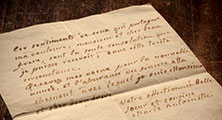Exhibition | Lux in Arcana: The Vatican Secret Archives
Thanks to Hélène Bremer for drawing my attention to this exhibition in Rome. If only things revealed themselves! -CH
Lux in Arcana: The Vatican Secret Archives Reveals Itself
Musei Capitolini, Rome, 1 March — 9 September 2012
It will be the first and possibly the only time in history that they leave the confines of the Vatican City walls. And they will do so in order to be housed and displayed in the beautiful halls of the Capitoline Museums in Rome. One hundred original and priceless documents selected among the treasures preserved and cherished by the Vatican Secret Archives for centuries. The exhibition which is conceived for the 4th Centenary of the foundation of the Vatican Secret Archives aims at explaining and describing what the Pope’s archives are and how they work and, at the same time, at making the invisible visible, thus allowing access to some of the marvels enshrined in the Vatican Secret Archives’ 85 linear kilometers of shelving; records of an extraordinary historical value, covering a time-span that stretches from the 8th to the 20th century.
The name, Lux in arcana, conveys the exhibition’s main objective: the light piercing through the Archive’s innermost depths enlightens a reality which precludes a superficial knowledge and is only enjoyable by means of direct and concrete contact with the sources from the Archive, that opens the doors to the discovery of often unpublished history recounted in documents. The exhibition is enriched by multimedia installations, guided by an intriguing but rigorous historical narration, to allow the visitor to experience some famous events from the past and to “re-live” the documents, that will come to life with tales of the context and the people involved.
The 100 documents, chosen among manuscript codices, parchments, strings and registers, will remain at the Capitoline Museums for nearly seven months, from 1st March till September 2012. An extremely prestigious location, chosen to host this memorable event since it underlines the profound bond existing between the city of Rome and the Papacy since medieval times; the origins of both institutions involved in the event trace their roots back to Sixtus IV’s artistic sensibility; however, at the same time, the history enshrined in the Vatican Secret Archives is intertwined with the history of Italy, Europe and the World as a whole.
The Vatican Secret Archives represent a cultural world heritage centered in the city of Rome; for this very reason the exhibition has been conceived in cooperation with Roma Capitale, Assessorato alle Politiche Culturali e Centro Storico – Sovraintendenza ai Beni Culturali di Roma and Zètema Progetto Cultura. This memorable exhibition is already creating great expectations, fuelled by the mysterious fascination that the Vatican Secret Archives generate in the collective imagination. All of the above will make Lux in arcana – The Vatican Secret Archives reveals itself an event of unprecedented scientific and media importance.
◊ ◊ ◊ ◊ ◊
An eighteenth-century sample from the exhibition:
A Note from Prison by Marie Antoinette of France, ca. 1792-93
 The feelings of those who share my sorrow, my dear brother-in-law, are the only consolation I can receive in this sad circumstance. Please receive my wishes for the new year and reassurance of my sincere devotion, that I am, my dearest brother-in-law, your affectionate sister-in-law and cousin Marie Antoinette.
The feelings of those who share my sorrow, my dear brother-in-law, are the only consolation I can receive in this sad circumstance. Please receive my wishes for the new year and reassurance of my sincere devotion, that I am, my dearest brother-in-law, your affectionate sister-in-law and cousin Marie Antoinette.
A note with no date, just over ten lines in French, written in a clear and tidy script on a small sheet of paper, signed by the last queen of France. The contents of this dispirited message that bears no official character suggest it may have been written during one of the gloomiest periods in Marie Antoinette’s existence: between December 1792 and January 1793, just after the revolutionary tribunal’s death sentence against her husband Louis XVI, desacralized as “Citoyen Louis Capet”, and just before his execution on January 19, 1793. Marie Antoinette was held prisoner with all the royal family at the Tour du Temple, an ancient fortress built by the knights Templar in the 13th century. Anxious over her husband’s dire fate and certainly foreseeing her own death, the queen wrote this message to an unknown recipient, possibly Louis XVI’s brother, Charles Philippe, count of Artois and future king Charles X of France. Ten months after this note’s supposed date, Marie Antoinette’s curse fate unfolded: early on October 16, 1793, she was taken to the guillotine on a squalid barrow . . .
The full entry is available here (click on the letter on the far right side, second from the top).





























leave a comment